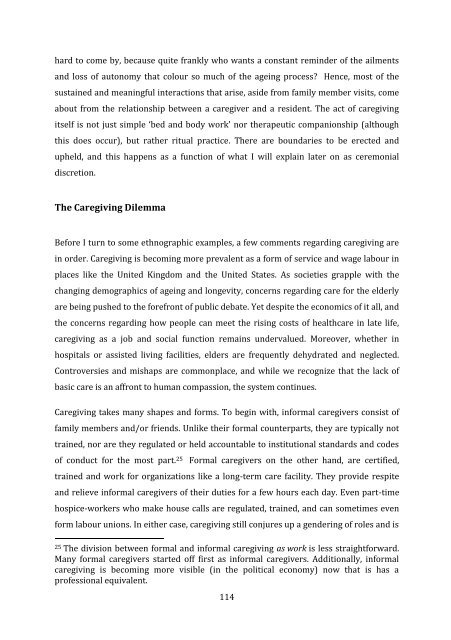Philip Y. Kao PhD thesis - Research@StAndrews:FullText
Philip Y. Kao PhD thesis - Research@StAndrews:FullText
Philip Y. Kao PhD thesis - Research@StAndrews:FullText
Create successful ePaper yourself
Turn your PDF publications into a flip-book with our unique Google optimized e-Paper software.
hard to come by, because quite frankly who wants a constant reminder of the ailments<br />
and loss of autonomy that colour so much of the ageing process? Hence, most of the<br />
sustained and meaningful interactions that arise, aside from family member visits, come<br />
about from the relationship between a caregiver and a resident. The act of caregiving<br />
itself is not just simple ‘bed and body work’ nor therapeutic companionship (although<br />
this does occur), but rather ritual practice. There are boundaries to be erected and<br />
upheld, and this happens as a function of what I will explain later on as ceremonial<br />
discretion.<br />
The Caregiving Dilemma<br />
Before I turn to some ethnographic examples, a few comments regarding caregiving are<br />
in order. Caregiving is becoming more prevalent as a form of service and wage labour in<br />
places like the United Kingdom and the United States. As societies grapple with the<br />
changing demographics of ageing and longevity, concerns regarding care for the elderly<br />
are being pushed to the forefront of public debate. Yet despite the economics of it all, and<br />
the concerns regarding how people can meet the rising costs of healthcare in late life,<br />
caregiving as a job and social function remains undervalued. Moreover, whether in<br />
hospitals or assisted living facilities, elders are frequently dehydrated and neglected.<br />
Controversies and mishaps are commonplace, and while we recognize that the lack of<br />
basic care is an affront to human compassion, the system continues.<br />
Caregiving takes many shapes and forms. To begin with, informal caregivers consist of<br />
family members and/or friends. Unlike their formal counterparts, they are typically not<br />
trained, nor are they regulated or held accountable to institutional standards and codes<br />
of conduct for the most part. 25 Formal caregivers on the other hand, are certified,<br />
trained and work for organizations like a long-term care facility. They provide respite<br />
and relieve informal caregivers of their duties for a few hours each day. Even part-time<br />
hospice-workers who make house calls are regulated, trained, and can sometimes even<br />
form labour unions. In either case, caregiving still conjures up a gendering of roles and is<br />
25 The division between formal and informal caregiving as work is less straightforward.<br />
Many formal caregivers started off first as informal caregivers. Additionally, informal<br />
caregiving is becoming more visible (in the political economy) now that is has a<br />
professional equivalent.<br />
114
















